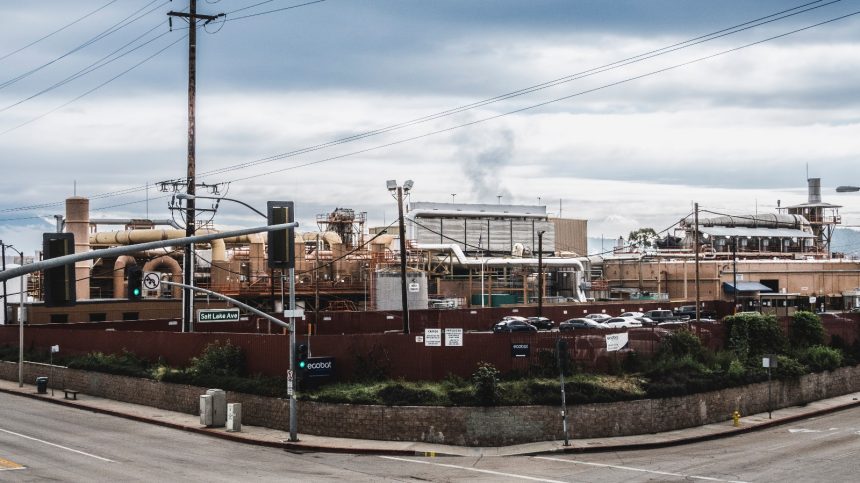This story is being co-published with Public Health Watch. West of the Rockies, just one lead battery recycler remains in the United States. If your car battery conks out in downtown Seattle or the Sonoran desert, it will probably be hauled to Ecobat, a lead smelter half an hour east of downtown Los Angeles. Ecobat’s facility in City of Industry melts down 600 tons of batteries and scrap every day. A conveyor belt takes the batteries to a hammer mill where they’re cracked open and slammed into pieces. Then a furnace blasts them with 1,000 degrees of heat. The resulting ingots or “pigs” of lead then ride on, to become batteries once again.
Nationally, about 130 million car batteries meet this fate each year. Fewer than a dozen smelters do this work in the U.S. No other consumer product in the country closes its recycling loop so completely. But the crucial business of smelting lead is also a very dirty one. Lead is a neurotoxin; no known levels of it are safe. People who breathe airborne particles of lead or accidentally put it in their mouths — especially children — can suffer nerve disorders and developmental problems. The smelting process itself can create a cancer risk. In addition to lead, it can send arsenic, hexavalent chromium, formaldehyde and other chemicals into the air.
Read Next California has some of the tightest toxic regulations and strictest air pollution rules for smelters in the country. But some residents of the suburban neighborhoods around Ecobat don’t trust the system to protect them.
Tens of thousands of people live in the bedroom communities of Hacienda Heights, La Puente, and Avocado Heights, including some just hundreds of feet from the edge of the company’s property. Uncertainty, both about the safety of Ecobat’s operation going forward and the legacy of lead it has left behind, weighs heavily on them. For decades, thousands of pounds of lead poured out of the smelter’s stacks. Soil testing has revealed high levels of lead on some properties over the years, but hasn’t led to a full investigation. Although pollution controls have squashed airborne lead to a fraction of its historical highs, Ecobat — known until recently as Quemetco — has amassed nearly $3 million in regulatory penalties since 2020.
The facility is operating under a permit that expired almost nine years ago. The Department of Toxic Substances Control, or DTSC, which oversees California’s hazardous waste laws, has sent back the company’s application for renewal three times. Once the filing is complete, DTSC will release a draft permit to the public for comment.
But the release date listed on the department’s website keeps shifting — from February, to March, to April, and as of this week, May.
In the meantime, long-brewing disputes among residents, the company, and regulators are again erupting into public view. Laws don’t mean much, say neighborhood advocates, if nobody enforces them.
“The regulators, they back down,” said Rebecca Overmyer-Velázquez, a coordinator with the Clean Air Coalition of North Whittier & Avocado Heights. “That’s really our biggest problem.”
Rebecca Overmeyer Vasquez, facilitator for the Clean Air Coalition of North Whittier and Avocado Heights, photographed at Whittier College. Chava Sanchez
In recent months, the dispute has taken on more of an edge. Younger activists impatient with the lack of progress are leading their own inquiry into soil contamination. Ecobat is suing the state over decisions related to the facility. Court filings and lawyers’ threats showcase a bitter and growing divide on questions of public health, responsible product management, and environmental safety.
“What they’ve really been denying the community is the ability to really call the question, should this facility, based on its past operation, receive a renewal of its hazardous waste permit?” said Angela Johnson Meszaros, an attorney at Earthjustice, which represents the Clean Air Coalition. “The community’s position is no. And I think that they have the receipts for why the answer is no.”
Ecobat did not make anyone available for an interview. In a written response to questions, Dan Kramer, a spokesman, said the company is “continuously committed” to protecting public health. “Ecobat’s number one priority is safety — for our employees, their families, and the people living and working in the communities surrounding our facility.”
At issue are not only how California protects public health going forward but also what regulators are willing to do about the past.
The Clean Air Coalition’s Overmyer-Velázquez wants her neighborhood to avoid what happened when another lead smelter closed south of downtown Los Angeles. Exide Technologies may have contaminated as many as 10,000 homes in predominantly Latino, working-class neighborhoods. When it abruptly shut down after 90 years, lawmakers and regulators vowed that Exide would pay to clean up neighborhood-level soil contamination. But in 2020 a bankruptcy court allowed the company to abandon the property, and the cleanup remains incomplete. The cost is ballooning, and so far Californians are paying for it.
Overmyer-Velázquez wants the Ecobat facility shut down, or moved away from densely populated Los Angeles County.
“This place has clearly demonstrated it cannot be a good neighbor,” she said.
DTSC did not make anyone available for an interview. In a written statement, a spokesman for the department said that it has made significant improvement to the permitting process, and that a decision on the facility’s permit “will be grounded in the latest scientific evidence regarding the potential impact of Ecobat’s operations on public health and the environment.” DTSC denied that the process has been delayed.
Half a century ago, after the Cuyahoga River burned in Ohio and as New York’s Love Canal raised national alarms about toxic waste, the Golden State was ahead of the game. California was vocal about the need to limit hazardous waste, to handle it safely, and to keep it local, rather than shipping it somewhere else, where laws are weaker. The state set stringent controls on storage and processing and began requiring permits for facilities. The company then called Quemetco filed for its first operating permit — a temporary one — in 1980.
But some of California’s management plans never materialized; some oversight, starved for staffing and funding, fell to shreds. It took 25 years for regulators to grant Quemetco a full hazardous waste permit.
Early on, environmental officials flagged reasons for concern about the lead smelter. State and federal regulators issued an order and a consent decree in 1987 because of the facility’s releases of hazardous waste into soil and water. An assessment from that time found “high potential for air releases of particulates concerning lead.”
Just a few blocks away from the Facility lies the residential community of Hacienda Heights. Chava Sanchez
It wasn’t illegal back then for Quemetco to send pollution straight into nearby San Jose Creek, or to dump battery waste into the dirt on a corner of the property without any formal containment. In 1987 alone, according to the federal Toxics Release Inventory, Quemetco reported that it had released nearly 4 tons of airborne lead from its stacks. That was okay, too.
By the 1990s, however, the science about lead was piling up, finding that the health hazards of even low levels of exposure were problematic, especially for children.
In the bedroom communities around Quemetco, neighbors took notice. At a public meeting in 1996, they asked why the permitting process was taking so long.
DTSC’s Phil Chandler, a soil geologist who was working on the facility’s permit at the time, answered the crowd. He explained that the delay was understandable.
“There was an awful lot of firms, like Quemetco, they came in the door, and said, ‘We want a permit.’ And they came all at once,” Chandler told residents back then. “So that’s been a problem.” More people began raising questions about lead-related health impacts.
Jeanie Thiessen, a special education teacher at a public school in the area, wanted her students to be tested for lead exposure. “Many exhibit signs of neuropsychological problems, cognitive impairments, become easily agitated, and have generally arrested development,” she wrote in a DTSC questionnaire. “Surely it is not normal to have so many children with learning disabilities come from so small an area.”
“I grew up with a lot of those kids,” said Duncan McKee, a longtime critic of the facility who lives in Avocado Heights. He says those worries were common. Looking back, he…






